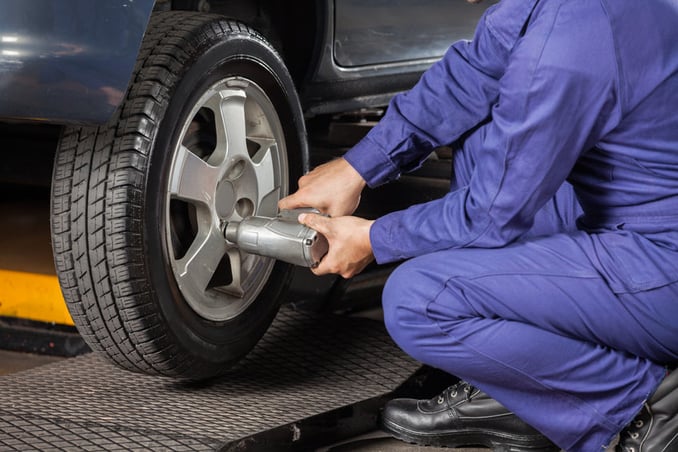Morris Tires: Where GMC Tire Service Fulfills High Quality
Morris Tires: Where GMC Tire Service Fulfills High Quality
Blog Article
Tire Solution: The Impact of Climate Condition
When it comes to guaranteeing optimal efficiency and security on the road, understanding the influence of climate problems on tire service is critical. GMC Tire Service. In this conversation, we will check out the detailed connection in between weather condition conditions and tire service, shedding light on the relevance of weather-specific tire maintenance techniques and factors to consider.
Warm and Tire Efficiency
When exposed to high temperature levels, tires experience modifications in efficiency that can considerably impact vehicle safety and handling. The warm generated from long term driving or warm weather condition problems triggers the tire rubber to soften, leading to minimized tread life and boosted wear.

Cold Weather Condition Results
Winter problems can have a significant effect on tire efficiency and security. As temperature levels decrease, tire rubber can set, bring about reduced grip on icy or snow-covered roads. In cool weather condition, tires may likewise shed atmospheric pressure extra rapidly, which can impact managing and fuel effectiveness. Additionally, cool temperature levels can create tire sidewalls to stiffen, boosting the danger of damages from fractures or other road risks.
To alleviate the results of winter on tires, it is crucial to regularly inspect tire stress and inflate them to the producer's suggested degrees. Utilizing winter or all-season tires designed for winter conditions can additionally improve grip and grasp on icy or snowy roads. Correct tire upkeep, including routine evaluations for wear and damage, becomes a lot more crucial during colder months to make certain optimum performance and security.
Rainy Issues Impact
Tires with worn-out footsteps are more prone to hydroplaning, where a layer of water develops up in between the tire and the road surface, leading to loss of traction. To combat this, motorists must consistently inspect their tires for ample walk depth and think about investing in tires particularly made for wet conditions.
Moreover, wet weather condition can also lower presence, making it challenging for vehicle drivers to see the roadway ahead clearly (GMC Tire Service). In such problems, it is vital to readjust driving rates appropriately and maintain a risk-free adhering to distance to enable for sudden stops. Effectively inflated tires can additionally assist in preserving control on wet roadways by providing much better handling and grip
Snow and Tire Safety
Snow-covered roads present one-of-a-kind obstacles for drivers, highlighting the importance of proper tire option and maintenance. When driving in snowy problems, having the ideal tires can make a substantial difference in safety and efficiency. Winter tires are designed with unique rubber compounds and tread patterns to provide better grip on snow and ice contrasted to all-season tires. The much deeper footsteps and sipes of wintertime tires aid hold the roadway better, decreasing the threat of navigate here sliding and sliding.

Additionally, chauffeurs ought to think about setting up tire chains in extreme snowy conditions. Tire chains offer additional traction by grasping the snow and ice, boosting stability and control. Nevertheless, it is necessary to adhere to maker instructions when mounting and utilizing tire chains to stop damage to the tires and automobile. By choosing the right tires, keeping correct rising cost of living, and taking into consideration added grip help like tire chains, vehicle drivers can enhance their safety when navigating snow-covered roads.
Weather-Related Tire Maintenance
When faced with different weather problems, appropriate tire upkeep becomes a critical aspect of automobile safety and security and performance. Weather-related tire maintenance includes a variety of methods intended at guaranteeing optimum tire feature and durability in different weather circumstances. One crucial element of weather-related tire maintenance is tire stress guideline. Changing temperatures can create tire stress to differ, influencing traction and fuel effectiveness. Routinely inspecting and adjusting tire pressure according to maker suggestions is important for website link secure driving in altering weather condition problems. In addition, tire walk deepness plays a substantial role in handling different weather components. Tires with ample tread deepness provide better grip on damp or icy roads, minimizing the threat of hydroplaning or skidding. When tread wear gets to a specific depth is vital for maintaining grip and security in adverse climate, evaluating tire walk frequently Find Out More and changing tires. By prioritizing weather-related tire upkeep, chauffeurs can boost safety, enhance lorry efficiency, and lengthen the lifespan of their tires.
Conclusion
Finally, weather have a substantial influence on tire efficiency and safety. From warmth affecting tire stress and put on to winter lowering grip, it is important to think about the weather condition when maintaining and making use of tires. Stormy problems can reduce grasp and lead to hydroplaning, while snow can enhance the risk of accidents if tires are not correctly furnished. Weather-related tire maintenance is crucial in ensuring ideal efficiency and safety when traveling.
In this discussion, we will explore the detailed relationship between weather condition problems and tire service, shedding light on the relevance of weather-specific tire maintenance practices and considerations.

Report this page